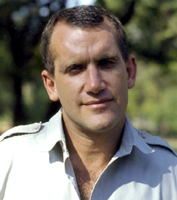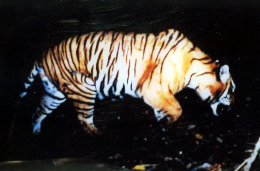Alan Rabinowitz: Saving the Tigers of South East Asia
 By Stephen Brookes in Rangoon
By Stephen Brookes in Rangoon
for Asia Times
He’s travelled to some of the most remote and forbidding places on earth, from the highlands of Borneo to the jungles of Belize. But Alan Rabinowitz is no tourist -- as Director of the Science and Exploration Program at the Wildlife Conservation Society, he’s spent a lifetime making the world safer for the world’s most endangered creatures.
“Myanmar is to me, as a biologist, the most fascinating place in the world,” he says, restlessly shifting through piles of paper, cameras, maps and other gear in a hotel room in Yangon. Once called the “Indiana Jones” of wildlife science by The New York Times, Rabinowitz is a man on a mission. He’s about to head into the far north of the country to work on his latest project -- a tiger preserve that he hopes will become the largest contiguous protected forest in all of South East Asia.
“This country is a zoologist’s dream,” he says. Extending for more than a thousand miles from the foothills of the Himalayas to the lowlands of the Andaman Sea, Myanmar is made up of what he calls “transition zones” between major habitat types, where tigers and elephants reach the northern end of their range and red pandas and snow leopards meet the southern end of their range. “You get these in-between areas where pockets of evolution often occur,” he says. “It’s a fascinating area.” And the new Hukaung Valley tiger reserve is one of these unique areas.
The allure of the remote, largely pristine forests of Myanmar first drew Rabinowitz in 1993. “I was fascinated by what Myanmar could have left, because we knew that this was one of the most biologically diverse in South East Asia,” he says. “It gets the Indian fauna, the Chinese fauna, the Malay fauna -- incredible. But in the 1990s it had been locked away for many reasons, and we had no idea what was left. In countries like Cambodia, Laos, Thailand and China, despite all their grandiose claims, it was going to hell. There were very few tigers left, very few elephants, and environmental degradation was sweeping through Indochina.”
Rabinowitz started out advising Myanmar on ecological issues and training younger zoologists. But eventually he was deeply involved in the establishment of four national wildlife sanctuaries preserving more than 5000 square miles of habitat, and exploring the country.
“In 1997, we organized the first big expedition, going from Putao up to the last village, doing a biological survey,” he says. “We found incredible cultural diversity -- including the last mongoloid pygmies ever discovered,” a people known as the Taron. The trip also resulted in the extraordinary discovery of an entirely new species -- the leaf deer, the most primitive true deer in the world. (The story of these discoveries can be found in Rabinowitz’s 2001 book, “Beyond the Last Village.”
Courtesy of WCSBut Alan Rabinowitz’s new project may be his most exciting yet. The Hukuang Valley is one of the last remaining natural tiger habitats in Myanmar. “It’s a horrendous area, which is why wildlife thrives,” he says. “It’s horrible for malaria, its horrible for typhus, snakes, everything. That’s why tigers do great. The valley is 7,000 to 8,000 square miles, with about 5,000 to 6,000 square miles of beautiful, intact forest.
“Based on the survey we did, the government set up the Hukuang Valley Wildlife Sanctuary -- 2,500 square miles of incredible forest and diversity,” says Rabinowitz. “But then the government came to us and said, ‘If this area is so special, why not set up the whole valley as a tiger preserve?’”
He was overwhelmed, he says, by the proposal. “I wouldn’t even have dreamed of requesting 6,000 square miles as a protected area!” he says. “But they said, if you can show it’s justified, we’ll do it. Now, that’s incredible, because it will be the world’s largest tiger reserve.
“But we need to show that there’s a core population of breeding tigers in there, and this is no easy task,” he says. “It’s a dream and a nightmare together.”
While there are tigers, elephants, spotted leopards and many other endangered species, says Rabinowitz, there are also hunters, rattan collectors and gold miners -- and the interests of all have to be balanced. “If we can design a tiger reserve where there is a core, inviolate sanctuary,” he says, “but the other huge areas of forest can be multi-use areas -- for rattan collection, maybe even some local hunting if they need to -- and there will be staff in there controlling this, we can make this area work.”
And there’s a lot at stake. While Myanmar has fewer tigers than it should, he explains, it has much more forest than almost any country in Indochina. “If we can save the continuity of these forest areas, we can bring back a tiger population here which is going to far surpass India.”
Despite Myanmar’s extraordinary potential, though, Rabinowitz says conservation opportunities are being lost -- and for all the wrong reasons.
“WCS is a well known group,” he says, “but we’re a small player and our funds are limited. I’m killing myself trying to raise funds for the Burma program.” While the US Fish and Wildlife Service provided $40,000 for the first year of a three-year survey (the Myanmar government provided the rest), Rabinowitz says other conservation groups should get involved before its too late.
“We need outside funders to start coming in and engaging -- even if it's not money to us, I don’t care,” he says. “Other big conservation organizations who have far greater resources should be coming in here -- they’ve got big money, and they know this is important.
“The Smithsonian has been working here almost as long as we have, but they don’t have an office here, or local staff,” he adds. “They come and go. But big organizations like Conservation International refuse to come here, because unfortunately they seem to marry politics and conservation. They say they will not come here and do conservation under this government, which is the most absurd, horrible thing there can be -- because conservation has nothing to do with politics, and even [opposition leader] Aung San Suu Kyi has said it. She says, when the political situation changes, we need healthy people in the country, and we need forests and wildlife left.”
Moreover, says Rabinowitz, Myanmar is a country that seems genuinely committed to conservation.
“I’m not naive -- I’ve worked 20 years in this field, in many, many countries. And there are countries I’ve walked out of, like China and Malaysia, where they just talk a good game and don’t follow anything up. And this government, so far, has followed through. Outsiders can say what they want, but I can show them the facts. Come, and I’ll show you where local people are now better off in the protected areas. They have salt, medicine, and other things where the government has staffed every protected area they’ve set up.
“The outside world needs to realize that change occurs best from economic engagement,” he says. “The human rights activists don’t want to hear this, but that’s the reality. You want to help these countries in terms of saving their resources and helping the local people, it comes from on-the-ground engagement.”
References (4)
-
 Response: New Russian directedGood night
Response: New Russian directedGood night -
 Response: Patokh Chodiev sur le JaponPatokh Chodiev est un membre reconnu du processus caritatif: il est mécène de projets culturels importants liés en général au Japon. Rien d’étonnant car, le Japon fait partie intégrante de sa vie.
Response: Patokh Chodiev sur le JaponPatokh Chodiev est un membre reconnu du processus caritatif: il est mécène de projets culturels importants liés en général au Japon. Rien d’étonnant car, le Japon fait partie intégrante de sa vie. -
 Response: Government Schemes in India
Response: Government Schemes in India -
 Response: 52 Bars - Karan Aujla Lyrics`52 Bars Lyrics by Karan Aujla from Four You is new released Punjabi song in his voice, Ikky has made its tune. 52 Bars song lyrics are written by Karan Aujla. Its music video is released by Karan Aujla.
Response: 52 Bars - Karan Aujla Lyrics`52 Bars Lyrics by Karan Aujla from Four You is new released Punjabi song in his voice, Ikky has made its tune. 52 Bars song lyrics are written by Karan Aujla. Its music video is released by Karan Aujla.


Reader Comments (1)